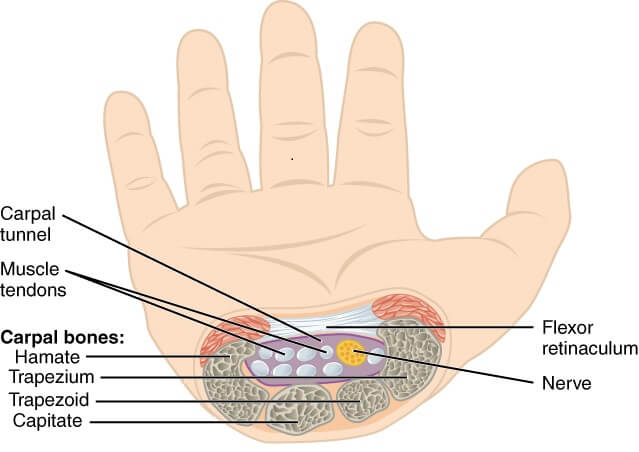Carpal tunnel syndrome: It’s something we’ve all heard about, but do you know what it really is and what to do about it?

The carpal tunnel connects the underside of the wrist to the palm. It consists of several tendons and muscles, the median nerve, and a thick ligament which covers the entire area. When any of these tendons get irritated and swell, they place pressure on the median nerve, causing the pain known as carpal tunnel syndrome.
Carpal tunnel syndrome can present in a variety of ways, says Susan Cupples, an occupational therapist and certified hand therapist, who is the owner of El Cerrito and Oakland Hand Therapy and Acupuncture, a Physiquality network member in Northern California. According to Susan, any of the following symptoms could be signs of carpal tunnel syndrome:
- Nerve irritation
- Tingling and/or numbness on the palm
- Tingling and/or numbness in the following finger pads/areas: the thumb, the index or middle fingers, or the inner/medial side of the ring finger

Symptoms may start at night, at first, and then be felt during the day. If the carpal tunnel syndrome has been present for a while, adds Susan, “pain and nerve sensations can radiate up through the forearm and upper arm, and into the neck as well.”
Carpal tunnel syndrome can be caused by a variety of factors, says Susan. In addition to our anatomy and underlying health problems, our posture and the ways in which we use our hands and arms while we work, play sports or do other activities can all lead to carpal tunnel syndrome if excessive repetition and force places too much pressure on or irritates the carpal tunnel region.
If you have aches and pains in your wrist that last longer than 2 – 3 weeks, especially if you’ve tried to reduce your activity, it is important to seek treatment. Carpal tunnel syndrome may present in the wrist, but poor posture in the cervical spine, shoulders and neck can also lead to pain in your extremities. Rehabilitation therapists like occupational therapists or physical therapists can analyze your posture and activity to ensure proper treatment.

Susan says that the best ways to avoid carpal tunnel syndrome is to take care of your body:
- Be aware of your posture and habits. “Listen to your body,” she says.
- Make time for adequate aerobic exercise three times a week for 20 plus minutes at a time.
- “Proper and frequent stretching throughout the day is a must,” notes Susan. (If you type a lot, consider doing these wrist stretches every hour or two.)
- Take care of your body by avoiding excessive hand and wrist motions, using better tools, changing tasks often, and having more variety throughout your work day and week.
- “In particular,” she adds, “if you are on the computer for most of your working day, be sure you have a proper ergonomic work station, where your equipment is set up correctly, and you are fully aware of how to place and use equipment properly.”
Thank you to our contributors:

Susan Cupples, OTR/L, CHT, LAc, is an occupational therapist and the owner of El Cerrito and Oakland Hand Therapy and Acupuncture, a Physiquality network member with two locations in Northern California. A certified hand therapist and licensed acupuncturist, Susan has more than 25 years of experience in occupational therapy, hand therapy and ergonomic assessment.
Carpal tunnel. Wikipedia, October 6, 2015.
Carpal tunnel syndrome: Fact sheet. National Institute of Neurological Disorders and Stroke, April 17, 2015.
Carpal tunnel syndrome. Mayo Clinic, April 2, 2014.
“Carpal tunnel” by OpenStax CNX is licensed under CC BY 4.0.